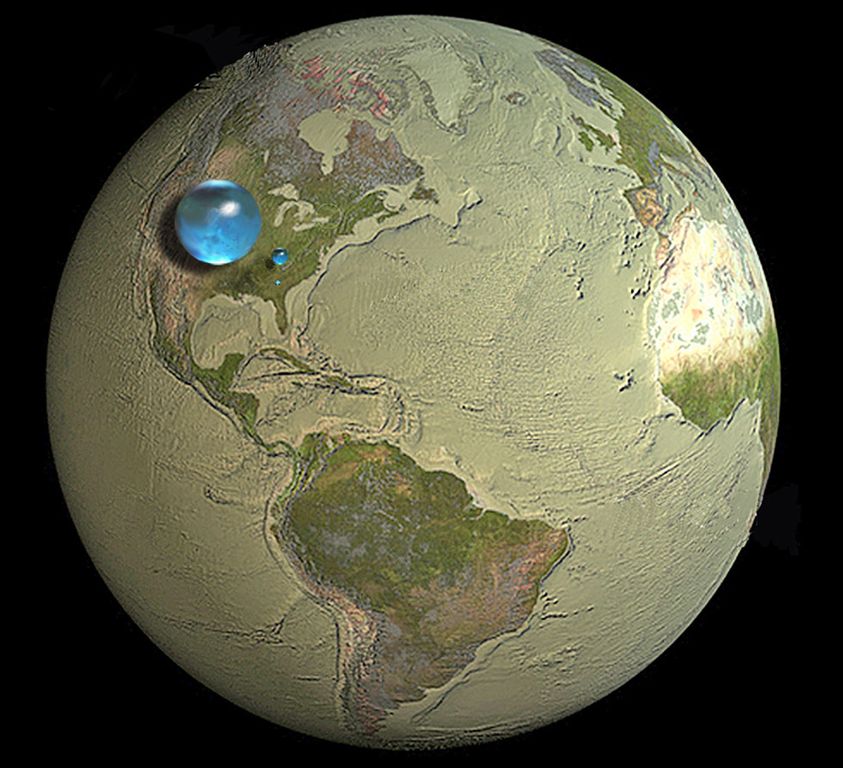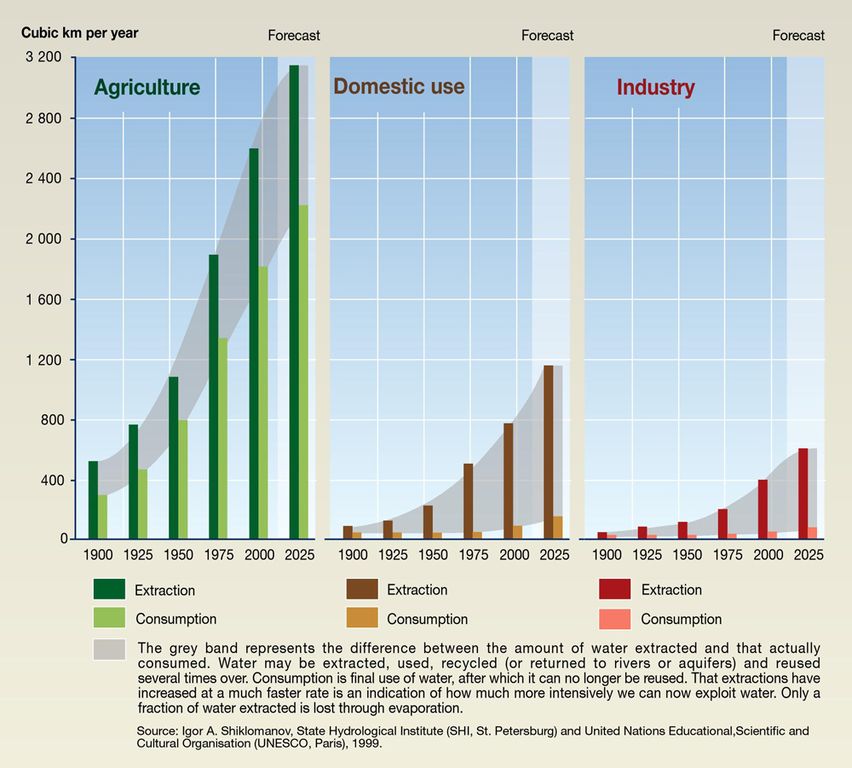
The importance of freshwater to all life cannot be understated. Not only is it absolutely essential for all living organisms to live, thrive and survive, it is the very basis of civilization as we know it. Agriculture, sanitation, and healthy living are entirely dependent on the steady supply of clean water; and without it, society would crumble. Little wonder then why, with the Earth's population continuing to grow, that many fear for our planet's fresh water supply.
Globally, our consumption of this limited resource continues to rise - thanks to population growth, the growth of urban centers, and increased life expectancy. What's worse, humanity's impact on the planet is also causing considerable problems. In addition to polluting our rivers, lakes, and groundwater with toxic runoff, chemicals and waste, climate change is also causing an apparent decrease in the amount of freshwater we have available.
As Larry West, an environmental expert and journalist, explained: "If global warming continues to melt glaciers in the polar regions, as expected, the supply of fresh water may actually decrease. First, fresh water from the melting glaciers will mingle with salt water in the oceans and become too salty to drink. Second, the increased ocean volume will cause sea levels to rise, contaminating freshwater sources along coastal regions with seawater."

Artist's impression of all the Earth's water, liquid fresh water, and water in lakes and rivers. Credit: USGS/WHOI
With demand increasing and supply slowly diminishing, innovative solutions are required. Already, a great deal of work is being done to produce more freshwater from the planet's ample supply of salt water (i.e. desalination). But other efforts are focused on getting more use out of the freshwater we already have. In this respect, grey-water recycling is our best bet for seeing to our freshwater needs without drastically altering our habits.
According to the World Business Council for Sustainable Development (WBCSD) and the World Water Assessment Programme (WWAP), it is estimated that between 8% and 10% of worldwide water use is for household purposes. In developed nations, this works out to about 50 liters a day used for cooking, drinking and washing, with no account for gardening. To top it off, all of this water is of drinking-level quality (i.e. potable), but only a small fraction of it is actually being used for that purpose.
In fact, just 10% of household water consumption is actually used for food preparation and drinking. Another 25% goes towards laundry and household cleaning, while the remaining 65% goes towards sanitation and showering/bathing. Given that these last two aspects of our household habits are the largest consumers, and that urban populations and freshwater use are on the rise worldwide, a common solution seems in order.

The breakdown of global water consumption, according to the State Hydrological Institute. Credit: SHI/UNESCO
Enter the ReFlow G2R2, the world's first compact, shower/bath-to-toilet grey-water recycling system. Invented by Green Water Solution, a Vancouver-based start-up that specializes in water conservation, this filtration/pumping system allows users to recycle their bath and shower water (which alone accounts for 35% of our daily water use) and convert it into flush water.
The system is decentralized and can save up to 30% of the average household freshwater consumption, reducing both waste and household water expenses. What's more, it is the first greywater recycling system that does not require wall renovations or additional plumbing in order to be added to an existing bathroom. All these features mean that the ReFlow costs roughly one-third of what conventional greywater systems go for.
The company behind the system is Green Water Solution, which was founded in 2010 by Marrett Green. As an award-winning news anchor/journalist, curriculum developer at the British Columbia Institute of Technology, teacher at Kwantlen Polytechnic University, and the founder of the Canadian Flowers for Food Society - a non-profit organization dedicated to helping marginalized people become self-employed - Green is no stranger to social issues, technical challenges, or the need for innovative solutions.
"Reusing grey-water to flush toilets has long been considered a viable and sensible approach to conserving our fresh water," says Green. "And, existing systems are too costly by any standard. The ReFlow system is unique on many levels in allowing houses as well as condos and apartments to conserve freshwater while saving on utility bills."

Designer's concept of the ReFlow G2R2 retrofitted into an existing bathroom. Credit: greenwatersolution4u.com
"Our goal was to design more of a fixture than an appliance to make the system widely acceptable," he adds. "The ReFlow G2RS offers immediate freshwater conservation with no need for pipe retrofits, wall renovations, or change of social habits, a viable means of conserving our planet's number one Life providing resource."
Joined by a team of dedicated engineers, graphic designers, communications and technical experts, Green and his company have been working for the past five years to make the ReFlow G2R2 system a reality. This began in earnest in 2011, with feasibility studies conducted by Codetta Industrial Design - a Victoria, BC-based industrial design firm - that indicated that the G2R2 was a solid concept that could be tooled for mass consumption.
Over the next few years, Green and the company he founded went on to develop and test a proof-of-concept model, designed new features which expanded the system's functionality, and explore the concept's market potential. With help from the National Research Council (NRC) and the BC Cleantech Company Mentorship Program, they were able to work out all the kinks and make the system work.
Recently, they completed work on a final prototype (shown below), which features a pump that can accommodate varying sizes of bathroom pipes (and is very quiet), a three- dimensional water filter element that removes lint and hair, and a disinfection unit that removes pathogens. Other features include a towel warmer, running lights, and functional cabinets and shelf space, all of which ensure that it fits right into the bathroom environment.

The ReFlow G2R2 final prototype in an existing bathroom. Note the running lights which help people find there way in the night. Credit: greenwatersolution4u.com
The ReFlow also comes with a specialized intake nozzle that is able to adapt to the two standard configurations for bathtub overflow drains - these being the T-connection and u-pipe. It is also able to store 70 liters of grey-water, which is more than enough for the average household use. The design adheres to international plumbing codes, and meets health standards for reclaimed water and reuse.
Last, but certainly not least, the system is configured to take up very little space. At just 20 centimeters (6-7 inches) in width and 2.13 meters (7 feet) in height, the ReFlow system is slender enough - and short enough - to fit into just about any apartment/condominium bathroom. But perhaps its most appealing aspect is the environmental benefits it offers beyond simply saving on freshwater consumption.
As Julian Taylor, a partner at PraxisPoint - a Vancouver-based consulting firm dedicated to helping businesses transition to a greener economic model - explained: "Not only does it reduce water demand, but it reduces pressure on sewer systems. This has obvious benefits in reducing the stress on water systems, and helps the local ecology."
Earlier today, the company launched a crowdfunding campaign via Indiegogo to raise the necessary funds to bring the system to market. If successful, they hope to begin delivering models of the G2R2 to homes, apartments and condominiums all across North America. Current price estimates place the cost of each unit at $850 USD.
For this one-time price, and no installation fees, people can look forward to saving up to one-third on their water utility bills. In addition, they will be secure in the knowledge that they are helping to make a difference. As water tables, rivers and lakes dry up, and water consumption continues to be at an all-time high in the developed world, reducing and reusing our stores of freshwater will ensure that we will reduce the impact we are making on the planet.
And be sure to check out Green Water Solution's promotional video for the ReFlow G2R2 and water conservation:
Sources:
- HeroX.com/news/162-the-challenge-of-desalination/
- greenwatersolution4u.com/
- www.praxinc.com/contact/
- www.unep.org/dewa/vitalwater/article48.html
- http://www.eea.europa.eu/articles/water-in-the-city
- environment.about.com/od/globalwarming/a/waterinvesting.htm
- www.unesco.org/new/en/natural-sciences/environment/water/wwap/
- www.indiegogo.com/projects/the-reflow-g2rs-shower-to-toilet-recycling-system/
- globeadvisors.ca/partnership-development/cleantech-mentorship-program.aspx
- www.wbcsd.org/PagesX/EDocument/EDocumentDetails.aspx?ID=137&NoSearchContextKey=true








